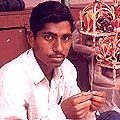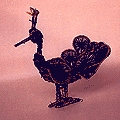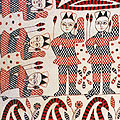Oryzasative or unhusked rice has been used for making chains, figures of deities, animal figures, flowers, garlands and other objects. This painfully laborious craft – practised in some parts of Balasore, Koraput, Bolangir and Kalahandi in Odisha – requires meticulous attention and minute detailing. The prices levied for the products are exceeding low and not commensurate with the labour involved. No tools are required, rice grain and cotton cord being the only raw materials used. The origin of the craft is lost though the practitioners know that their families have been practising it for many generations and that there is ritualistic significance in the crafting of Goddess Laxmi. The use of paddy is also symbolic of prosperity, a good harvest and general well being.
The paddy craft is practised by the Ghond tribes of Odisha residing in Dumermunda near Kesinga of undivided Kalahandi district, Titilagarh, Kumudipadar and the Saraibahal area of Bolangir district of undivided Koraput. Barely 15 to 20 families practise the craft during lean agricultural months and the products are sold mainly at local haths (markets), though some of the artisans have access to urban craft bazaars.

The products painstakingly pieced together include images of Goddess Laxmi, elephants, vahanas (chariots), tribal marriage crowns, images of temples, hand fans and baskets.

No formal tools are used and the raw material required is mainly unhusked paddy seeds of uniform size which is available locally. The artisan also requires thin bamboo sticks and strong yarn in red, green and yellow colour(s). The process involves tying by hand each individual paddy seed with the help of two thin bamboo sticks placed parallel to each other at a minute distance sufficient to hold the paddy seeds tightly in a straight line. This is a very painstaking and repetitive job that requires concentration and great dexterity. Each and every seed of paddy has to be individually knotted. In this manner straight lines are formed with different coloured threads and kept ready for the making of different shapes. The length of each of these paddy garlands is approximately one yard. About ten paddy garlands are required to create 30 pieces of Goddess Laxmi in a medium size. Each of these pieces is sold at a nominal rate. After household chores are over women and children usually perform the hard task of making the paddy garlands in their spare time; both the men and women then craft the final images.
The craft has been mentioned by T. N. Mukherjee in his book Art Manufacturers of India published in 1888 for the Glasgow International Exhibition. Mukherjee writes that chains made of unhusked rice were crafted in Gushkara village in Burdwan District of West Bengal. The difficulty in accessing the artisans in their relatively remote location is an additional difficulty in helping revive the craft.


